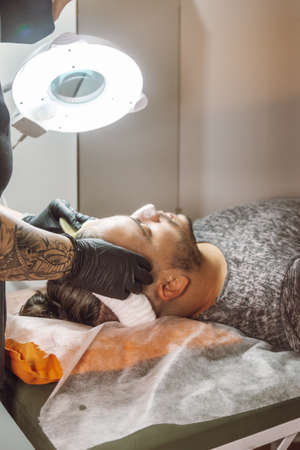Understanding the Healing Process
When it comes to tattoo removal, understanding how your skin heals is the first step towards ensuring optimal recovery and minimising the risk of scarring. Immediately after your session, your body’s natural healing mechanisms go to work. In the initial days, you may notice redness, swelling, and a sensation similar to mild sunburn – all perfectly normal responses as your skin begins its repair journey. Over the following week or so, you might experience some blistering or scabbing; this is your body’s way of protecting the treated area and should not be picked at. As days turn into weeks, these symptoms gradually subside, giving way to new skin formation beneath. It’s essential to stay patient during this period – every individual heals at their own pace, and factors such as skin type, treatment intensity, and overall health play a role in recovery time. By recognising these stages and knowing what to expect, you’ll feel more confident in navigating the process and making informed choices for your aftercare routine.
2. Cleansing and Care: Keeping It Clean
After undergoing tattoo removal, keeping the treated area clean is absolutely crucial to prevent infection and support your skin’s natural healing process. In the UK, where environmental factors can vary, it’s important to adhere to best practices tailored for British conditions and make use of trusted local products. Here’s how you can confidently maintain a hygienic environment while treating your skin with the kindness it deserves.
Best Practices for Gentle Cleansing
- Wash your hands thoroughly before touching the treated area. This simple step is your first defence against bacteria.
- Use lukewarm water, as hot water can irritate sensitive, healing skin. Gently splash the area—avoid soaking or scrubbing.
- Choose a mild, fragrance-free cleanser. Steer clear of harsh soaps or chemicals that might disrupt the delicate healing process.
- Pat dry with a clean towel. Do not rub or apply pressure; gentle dabbing helps avoid unnecessary trauma to the skin.
Recommended British Products for Aftercare
| Product | Type | Main Benefit | Why It’s Suitable |
|---|---|---|---|
| Cetraben Cream | Moisturiser | Soothe & Hydrate | Nourishes without irritating sensitive skin, widely available in UK pharmacies |
| E45 Wash Cream | Cleansing Lotion | Gentle Cleanser | Soap-free and perfect for fragile post-treatment skin |
| Sterile Saline Solution (Boots) | Wound Rinse | Cleanses Safely | Easily accessible and ideal for rinsing away debris without stinging |
| Aquaphor Healing Ointment (UK version) | Barrier Cream | Protect & Repair | Forms a protective barrier, allowing optimal healing conditions while preventing infection risk |
Tips for Maintaining a Hygienic Environment
- Avoid touching or picking at scabs or blisters. Let your body heal naturally; interference may increase scarring risks.
- Change bedding regularly, especially pillowcases, to minimise exposure to bacteria during recovery.
- Avoid public pools, saunas, and gyms for at least two weeks post-treatment to protect against possible infections.
- If covering the area is necessary, use a sterile, non-stick dressing and change it daily or as advised by your practitioner.
- Monitor for signs of infection, such as excessive redness, swelling, or discharge, and seek medical advice promptly if you notice any changes.
A Little Kindness Goes a Long Way
Your skin has been through quite an ordeal—treat it with patience and respect. By following these cleansing and care steps with diligence and gentleness, you are investing in a smoother recovery journey and minimising the chance of lasting marks. Remember: consistent aftercare isn’t just about looking good; it’s about feeling confident in your own skin every step of the way.

3. Moisturising and Barrier Protection
One of the most crucial steps in aftercare following tattoo removal is keeping your skin well-moisturised and protected. The treated area is often sensitive, and proper hydration not only soothes discomfort but also helps prevent scarring by supporting your skin’s natural healing processes.
In the UK, several moisturisers and ointments have earned trust for their gentle yet effective properties. Products such as E45 Cream, Cetraben, and Aveeno Daily Moisturising Lotion are widely recommended due to their fragrance-free formulations and ability to lock in moisture without irritating sensitive or healing skin. For those seeking an ointment rather than a lotion, Bepanthen Nappy Care Ointment is a popular choice for its soothing effect and barrier protection, even outside its traditional use.
To encourage optimal healing, apply your chosen moisturiser two to three times daily after gentle cleansing. Avoid products containing harsh chemicals, alcohol, or strong fragrances, as these can cause dryness or aggravate the delicate area. It’s also wise to steer clear of petroleum jelly unless specifically advised by your practitioner; while it forms a barrier, it can sometimes trap bacteria if the area isn’t fully healed.
Remember, consistency is key—keeping the skin supple reduces the risk of cracking or scabbing, both of which can contribute to scarring. If you notice persistent dryness or irritation despite diligent moisturising, consult with your clinician for tailored advice. By prioritising hydration and using tried-and-tested British favourites, you’re giving your skin the best possible chance to heal beautifully.
4. Sun Protection: Shielding Sensitive Skin
After tattoo removal, your skin becomes particularly vulnerable, making sun protection a non-negotiable aspect of aftercare. The unpredictable British weather may often lull us into complacency, but even on overcast days, UV rays can be powerful enough to impede healing and increase the risk of scarring or pigmentation changes. Shielding your sensitive skin from the British sun is not only about comfort—its crucial for optimal recovery and long-term results.
The Importance of Safeguarding Healing Skin
Freshly treated skin is thinner and more delicate than usual, leaving it highly susceptible to UV damage. Exposure to sunlight during the healing phase can worsen inflammation, prolong redness, and heighten the chances of permanent marks or uneven skin tone. Prioritising sun protection is one of the most effective ways to encourage healthy regeneration and maintain your confidence as you recover.
Recommended SPF Strength
For post-tattoo removal care in the UK, experts consistently recommend using a broad-spectrum sunscreen with a minimum SPF of 30, even during cloudier months. However, an SPF 50+ offers enhanced defence and is particularly wise if you have fair or sensitive skin. Reapplication is key; ensure you top up every two hours when outdoors for sustained coverage.
SPF Comparison Table
| SPF Level | Protection (%) | Recommended Use |
|---|---|---|
| SPF 30 | 97% | Everyday use in moderate conditions |
| SPF 50+ | 98%+ | Best for sensitive/healing skin and strong sunlight |
Practical Tips for Year-Round Protection
- Cover Up: Wear loose, breathable clothing that covers the treated area—think long sleeves or light scarves—even when its not blazing hot.
- Avoid Peak Hours: Try to stay indoors between 11am and 3pm, when UV rays are at their strongest in the UK.
- Sunscreen Application: Gently apply a generous amount of high-SPF sunscreen to the healed site at least 15 minutes before going out. Remember to reapply after sweating or if exposed to rain.
- Don’t Forget Indoors: UVA rays can penetrate windows, so stay protected whether youre driving or working by a sunny window.
- Stay Mindful All Year: Sun protection isn’t just for summer—UV rays are present year-round in Britain, so make daily application part of your routine.
Your Healing Journey Matters
Nurturing your skin with diligent sun protection reflects self-respect and care for your wellbeing. By adopting these sensible habits, you’ll empower your healing process and reduce the risk of scarring—helping you feel proud and confident in your skin’s renewed appearance.
5. Watch Outs: Recognising Signs of Complications
After undergoing tattoo removal, your journey to clear, healthy skin depends on keen attention to aftercare—especially when it comes to spotting complications early. While most people heal well with proper care, being able to identify warning signs helps prevent minor issues from becoming serious setbacks. Let’s explore what to watch out for and when it’s best to consult a professional or seek NHS advice for total peace of mind.
Spotting Early Signs of Infection
It’s perfectly normal for the treated area to feel tender, look slightly red, or swell a bit during the first few days. However, if you notice redness that intensifies or spreads, persistent warmth around the site, increasing pain, or pus-like discharge, these could be signs of infection. A mild temperature or feeling generally unwell may also accompany an infection. Trust your instincts—if something feels off, it’s worth taking seriously.
Recognising Adverse Reactions
Sometimes, your body may react unexpectedly to the laser treatment. Watch for unusual blistering beyond initial expectations, severe itching that doesn’t ease with recommended creams, or any rash that appears outside the treated area. Allergic reactions are rare but possible—look out for hives or swelling in places not directly treated.
When Should You Seek NHS Advice?
If you’re concerned about any of the symptoms above, don’t hesitate to contact your GP or local NHS 111 service. Prompt attention can make all the difference in preventing scarring or further complications. In the UK, you’re never alone—reaching out for reassurance or expert guidance is always encouraged and shows you’re taking responsible steps in your healing journey.
Your Confidence Matters
You deserve to feel secure and supported as you heal. By recognising early signs of trouble and knowing when to seek help, you protect both your skin and your confidence. Remember: swift action leads to better outcomes, so never feel embarrassed about seeking advice—it’s a strong and positive step towards optimal healing.
6. Gentle Lifestyle Adjustments
As you embark on your tattoo removal healing journey, embracing thoughtful lifestyle choices can make a real difference in preventing scarring and nurturing your skin’s recovery. While it’s natural to want to jump straight back into your daily routine, it’s wise to treat your body with extra care during this delicate phase.
Avoid Strenuous Activity
Intense exercise or activities that cause excessive sweating can irritate the treated area and potentially delay the healing process. For the first week or two post-procedure, opt for gentle walks and light stretching rather than hitting the gym hard or taking part in contact sports. Giving your skin this time reduces friction and minimises the risk of reopening any fragile skin.
Choose Comfortable Clothing
Your wardrobe matters more than you might think. Tight or abrasive clothing can rub against sensitive skin, increasing irritation and even triggering unwanted pigmentation changes. It’s best to wear loose-fitting, breathable fabrics—think soft cotton t-shirts or relaxed jumpers—to keep the area protected and comfortable while it heals. Avoid synthetic materials that trap moisture and could contribute to infection.
Protect Your Skin From the Elements
The British weather is famously unpredictable, but whether it’s sunny or drizzly, protecting your healing skin is essential. If you need to be outdoors, ensure the area is covered—not just from sunlight but also from wind and pollution, which can all aggravate sensitivity. If covering isn’t possible, a high-factor, fragrance-free sunscreen is your best friend once the initial healing has begun.
Prioritise Rest and Hydration
Your body does its best repair work when you’re well-rested and hydrated. Getting enough sleep each night supports cellular regeneration, while drinking plenty of water keeps your skin supple and flushes out toxins. These simple acts of self-care go a long way towards reducing inflammation and giving your skin every chance to heal smoothly.
By making these gentle adjustments to your lifestyle, you’re not just looking after your skin—you’re actively investing in your confidence and wellbeing for the future. Trust yourself to take things slow; every kind choice you make for your body now brings you one step closer to beautifully healed skin without scars.


